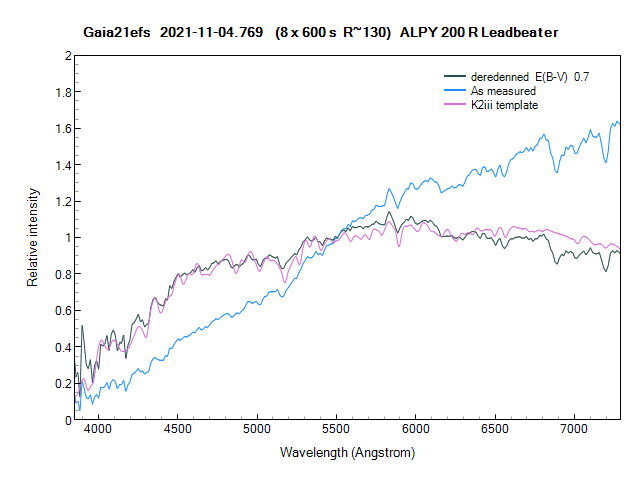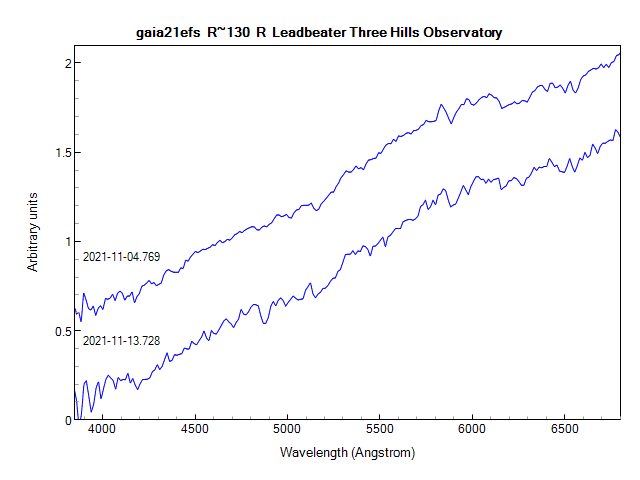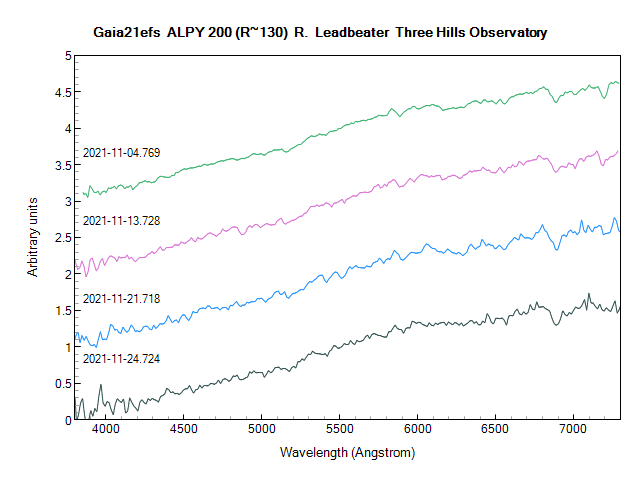› Forums › Exoplanets › Microlensing event – Gaia21efs
- This topic has 18 replies, 4 voices, and was last updated 4 years, 1 month ago by
 Robin Leadbeater.
Robin Leadbeater.
-
AuthorPosts
-
4 November 2021 at 9:25 am #575088
Roger Dymock
ParticipantWe have been asked by Siegfried Vanaverbeke to observe this object. Details are;
RA 20:29:41.9 Dec +31:17:43
Quiescent (Gaia) magnitude; 15.8
Time between observations; 1.0 day
Gaia alerts link (includes data and finder chart)
http://gsaweb.ast.cam.ac.uk/alerts/alert/Gaia21efs/Advice to imagers
To obtain the best approximation to Gaia magnitudes;
1) Use a Sloan r’ filter
or
2) Use a Cousins R filter but ensure target is above 20 degrees altitude
or
3) If imaging unfiltered ensure target is above 45 degrees altitude
and
4) Use Gaia DR2 data for obtaining magnitudes of comparison stars – https://www.cosmos.esa.int/web/gaia/data-release-2If using Astrometrica select;
1) Filter r’, R (Cousins) or Clear/None depending on filter used
2) Color Band G
3) Star Catalog Gaia DR2Please send observations to Roger Dymock. Email; roger.dymock’at’ntlworld.com
Data required;
Observing site
Observer, name
Photometric software
Photometric Catalogue used
Catalogue magnitude band
Date and time (JD) e.g., 59403.391447
Target e.g., Gaia21efs
Filter used
Magnitude
Error4 November 2021 at 8:33 pm #584888 Robin LeadbeaterParticipant
Robin LeadbeaterParticipantOn it now with the ALPY200. I make it roughly mag 13.5 unfiltered off the spectrograph guider so significantly brighter than at quiescence.
EDIT: I see that is consistent with the 13.64 V (APASS) at 16:20 today in the Gaia follow up data
5 November 2021 at 12:59 am #584889 Robin LeadbeaterParticipant
Robin LeadbeaterParticipantThe spectrum matches that of a highly reddened early K type star
 15 November 2021 at 3:44 pm #584908
15 November 2021 at 3:44 pm #584908 Robin LeadbeaterParticipant
Robin LeadbeaterParticipantIt has now faded ~1.3 mag since the previous spectrum and there has been no significant change, supporting the microlensing hypothesis.
Cheers
Robin
 16 November 2021 at 4:40 pm #584909
16 November 2021 at 4:40 pm #584909Roger Dymock
ParticipantHi Robin,
What would you expect to see if it wasn’t a microlensing event? Be stars are often quoted as possibilities for example,
Regards
16 November 2021 at 8:08 pm #584911 Robin LeadbeaterParticipant
Robin LeadbeaterParticipantHi Roger,
I saw a comment suggesting a Be star on the TNS discovery entry where it is AT2021ziw. I uploaded my spectrum there to eliminate that suggestion
https://www.wis-tns.org/object/2021ziw
but at the time the gaia team uploaded their discovery there it had only brightened by around 0.4 mag so I would have said the possibilities were pretty wide open at that point. That’s why a spectrum is useful.
Not sure why a brightening Be star would be singled out as a likely possibility, (there must be many mechanisms that can produce such an upward drift in brightness) but my first spectrum clearly eliminated that possibility and that given it looked like a pretty average K class star, probably many other alternatives. The shape and symmetry of the light curve now pretty much seals it as microlensing and my second spectrum supports that. (Only a microlensing event or eclipsing binary would be expected to leave the spectrum unchanged through a significant change in brightness)
I see there is now another spectrum in TNS, taken using the 3.8m Seimei telescope. Although higher resolution the features are the same as in my spectra. (There is a bit of difference in continuum slope, possibly down to my choice of reference star.)
Cheers
Robin
17 November 2021 at 9:03 am #584912Roger Dymock
ParticipantHi Robin,
Thanks for the explanation. Do you think this event would be worth a paper in the JBAA? I could do the handling of alerts and the photometry aspects but would look to you to cover the spectral side including how this confirms, or otherwise, a microlensing event.
Regards
17 November 2021 at 12:33 pm #584913 Robin LeadbeaterParticipant
Robin LeadbeaterParticipantHi Roger,
Spectra can only rule out or support the microlensing hypothesis, not confirm it. (Any changes in the spectrum would have indicated a potential alternative cause of the brightness change) but yes I am happy for my spectra to be included in a paper/article for the JBAA and I can supply a paragraph of explanation. (I will leave it to others to judge its merit as I have little knowledge of the subject)
Cheers
Robin
17 November 2021 at 7:08 pm #584918 Dr Paul LeylandParticipant
Dr Paul LeylandParticipantSounds good to me. Go for it!
18 November 2021 at 2:15 pm #584920 Daryl DobbsParticipant
Daryl DobbsParticipantI for one would love to see a paper on it in the JBAA
21 November 2021 at 11:53 am #584924Roger Dymock
ParticipantThanks for your comments – guess that means I am actually going to have to write it now –
b-gg-r!!!1 December 2021 at 11:01 am #584954Roger Dymock
ParticipantHave decided not to go ahead with the paper for a couple of reasons;
- observations dried up mostly due to bad weather at observing sights
- previous publication by the BAA Variable Star Section in their recent circular
Will wait until another good example arises.
1 December 2021 at 12:24 pm #584955 Robin LeadbeaterParticipant
Robin LeadbeaterParticipantAs well as my classifying spectrum mentioned in VSSC 190, I now have four spectra following this event as it faded down to ~16.3 g. (No change within the uncertainties as expected)

The spectra are in the BAA spectroscopic database but I will also put something on my BAA observations page sometime in the next few days with a few notes about them.
Cheers
Robin
4 December 2021 at 12:14 pm #584967Roger Dymock
ParticipantRobin,
Probably an obvious question but I assume the spectra in your post are those of the source star. Would these not be ‘contaminated’ by the lens star?
Regards4 December 2021 at 12:50 pm #584968 Robin LeadbeaterParticipant
Robin LeadbeaterParticipantYes the spectrum will be a blend but the lensing object must be very much fainter (or spectroscopically similar) as there is no evidence of any change in the spectrum even though the total brightness (driven by a change in the brightness of the lensed component) changed by a factor of ~25 (3.5 mag) I am not an expert on lensing but I think once we have a complete model we may have a distance and mass for the lensing component. That would also give an idea of how far back in time they would have been resolvable. Perhaps historical deep images would show something? (Of course not if it is a black hole though)
Cheers
Robin
4 December 2021 at 2:28 pm #584969 Robin LeadbeaterParticipant
Robin LeadbeaterParticipantHere is a similar event back in 2006 which went from mag 11.5 to mag 7.5. There were several papers on this eg this one with members of the amateur community (BAA/CBA etc) as co-authors
https://ui.adsabs.harvard.edu/abs/2008ApJ…677.1268G/abstract
which deduced the lensing object was likely a low mass star or brown dwarf. Their paper also suggested that it could be a a productive technique for discovering exoplanets.
(I believe my first (crude slitless) spectrum was the earliest of this object which alerted the community that this was something unusual though as far as I know that was not mentioned in any of the subsequent papers). I remember there was considerable scepticism at the time as lensing of such a bright target was considered unlikely but there have been a few more bright ones since then.
Cheers
Robin
7 December 2021 at 1:49 pm #584989Roger Dymock
ParticipantHi Robin,
Siegfried Vanaverbeke asks ‘Can an estimate of the angular size of the source star be derived from spectroscopy?’
Regards
7 December 2021 at 5:22 pm #584990 Robin LeadbeaterParticipant
Robin LeadbeaterParticipantI can’t offhand think of any way this could be determined spectroscopically. Do you have a suggestion? I am guessing that might be one of the parameters in the light curve fit but I don’t know the details.
Cheers
Robin
7 December 2021 at 5:27 pm #584991 Robin LeadbeaterParticipant
Robin LeadbeaterParticipantThe angular size of the lensed star could be inferred from the Gaia parallax, the apparent magnitude and the spectral classification.
-
AuthorPosts
- You must be logged in to reply to this topic.
